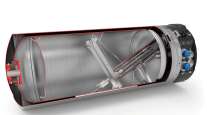Proper Lighting Gives Fleets Brighter Maintenance Outlook
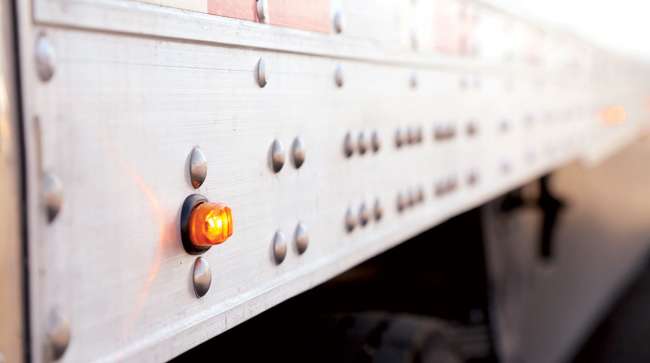
[Stay on top of transportation news: Get TTNews in your inbox.]
After a thorough assessment of your fleet’s trailer, you’ve checked the boxes, and every part and item is cleared for another run. However, even with federally required pre- and post-trip inspections, violations can occur, and lighting is one of the most common roadside violations that inspectors find.
“Even if the driver checked it in the morning, it could fail at some point throughout the day,” said Kerri Wirachowsky, director of the roadside inspection program for the Commercial Vehicle Safety Alliance (CVSA). One of the biggest challenges with lighting is it can go out at any time. Shana Hatch, compliance safety accountability manager for C.R England Inc., said a fuse can burn out or a connection can come loose, and the driver is not aware until they stop or are stopped roadside.
Plus, lights are exposed to the elements. “By the nature of its construction and placement on a vehicle, lighting tends to be more susceptible than other systems to the common highway hazards of moisture intrusion, corrosion and vibration,” said Mark Blackford, director of national fleet sales at Grote Industries.

Lasko
Lighting failures are one of the most observable violations, even when a vehicle is in motion.
“Lights are the most outward-facing element of compliance,” said Michael Lasko, director of environmental health and safety and quality for Billerica, Mass.-based Boyle Transportation. “They broadcast themselves as you’re going down the road.”
Fleets said they rely on education, inspections and technology to help minimize the risk of a failure. Boyle Transportation utilizes a multifaceted approach and hasn’t had a lighting violation in more than eight years, Lasko said. That starts with training when new drivers join the fleet.
“Drivers are all trained to replace the bulbs or fuses if they need to,” Lasko said, adding that Boyle Transportation provides bulbs, fuses and a pigtail tester to drivers. “We want our drivers to be competent and confident when they’re behind the wheel, so we provide them with the training and resources to achieve those goals.”
Pre- and Post-Trip Inspections
C.R. England’s Hatch said a thorough pre-trip inspection is one of the most important things drivers do to avoid Compliance, Safety, Accountability (CSA) violations as it drives the opportunity to have repairs made and helps to prevent breakdowns, violations and even crashes. “It also saves the driver and carrier time and money in the long run,” she said.
Based in Salt Lake City, C.R. England ranks No. 25 on the Transport Topics Top 100 list of the largest for-hire carriers in North America.

Cole
However, some drivers don’t take the time to do a good pre-trip inspection, said John Cole, director of safety for FirstFleet, based in Mufreesboro, Tenn. To encourage drivers to conduct a pre-trip as well as check the truck any time they stop in case something changed, FirstFleet offers a financial bonus for a clean DOT inspection at many of its locations.
This year, C.R. England added a promotion during CVSA’s Roadcheck. Drivers who attended the fleet’s pre-trip training and received a Clean Level 1 inspection won a prize package, Hatch said. At Boyle Transportation, which also offers a bonus for clean inspections, drivers submitted a driver-vehicle inspection report and checklist through the software platform Fleetio, which transmits information directly to the maintenance department.
Cole noted that post-trip inspections are just as crucial as pre-trip inspections. “You can find problems that need attention, and they can be repaired before the next driver picks that trailer up for a run,” he said.
Even if drivers are completing inspections, Wirachowsky acknowledged that it can be difficult for them to inspect brake lights. “You can’t have your foot on the brake and look at your brake lights at the same time,” she said, adding that there are automatic lighting tests. “If they don’t have something like that, they should have a stick or something to apply the brake.”
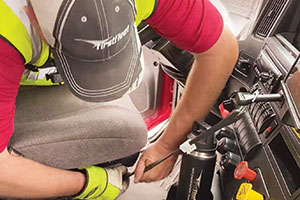
FirstFleet
FirstFleet has some models of trucks with a safety function that will cycle through all of the lights. “For those trucks that don’t have that feature, we ask our drivers to use a bungee cord, pull the hand valve down and secure it, and then walk to the rear of the trailer to make sure the brake lights are working,” Cole said.
C.R. England uses a pre-/post-trip light test feature that allows drivers to push the button in the cab and walk around their tractor and trailer as the lights cycle through. “The challenge comes when a bulb goes out or a connection comes loose while driving down the road,” Hatch said.
Blackford said the Grote Guardian Smart System can immediately detect an outage and notify the fleet of the trailer number and lamp circuit experiencing faults. The fleet then assigns a work order to the equipment before the unit even gets off the road.
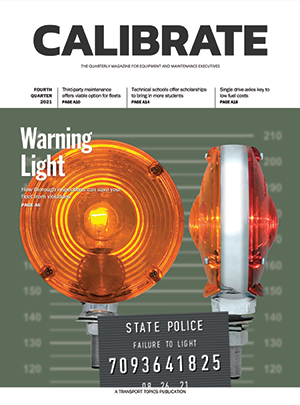
More Q4 Calibrate Stories
►Outsourcing Repair: Fleets Look to Third-Party Maintenance Services
►Scholarships Bring Opportunities to Students Looking for a Sustainable Career Path
►Single Drive Axles Could Reduce Your Fuel Bill
►2022 Is the Year of Research and Discovery for TMC and Its Partners
►Freeze: Trucking Again Shows It Is a Resilient Industry
Mark Johnson, chief marketing officer at Clarience Technologies, parent company to Truck-Lite and Road Ready, said trucking fleets consistently flagged for lighting violations can benefit from telematics. One of most popular features of Road Ready is the Light-Out Detection System that alerts the fleet manager when a light is not in proper working order on a trailer, he said.
“Also, if one particular driver consistently fails to identify or address lighting issues that should be discovered in the pre-trip inspections, then the fleet manager can proactively address the pattern with his driver and prevent future violations,” Johnson explained.
Lighting Solutions
Habitual issues often have their root cause in how the system is specified and installed, long before becoming a maintenance or pre-trip issue, Blackford said. “Fleets need to be sure they are outfitting their equipment with quality lights and harnesses, preferably from the same manufacturer, to ensure that all components are designed to work together perfectly,” he said.
Some fleets are turning to LED lamps, which Blackford said can be more robust than incandescent lights and reduce the risk of violations. “LED lights are also much less susceptible to damage from vibration and do not generate as much heat as an incandescent bulb, which generally guarantees a longer service life,” he said.
LEDs also last 20 times longer than bulbs. “What that means is if your LED light is out and it’s only a few years old, it’s most likely corrosion in the light, harness or connectors that is causing the light-out issue,” said Jeff Geoffroy, director of marketing for Peterson.
Corrosion-resistant harness systems help keep connectors protected from moisture and water. Geoffroy added that they have integrated moisture barriers to stop the spread of corrosion, and they are modular in design so a damaged wire can be replaced without cutting and splicing that creates weak points in the trailer harness.
When LED lights go out, it is generally in clusters. “You can have a cluster of lights go out but still give the amount of light required by the regulation,” Wirachowsky said, adding that there is no current regulation in the U.S. to how many diodes have to be out before the light is considered not functioning. “That gives the industry the opportunity to fix the diodes that are out without going into violation.”
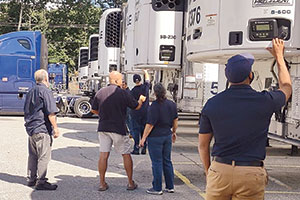
Boyle Transportation
Boyle Transportation uses LED lights on tractors but not trailers. “It is much easier to train the drivers with bulbs and fuses rather than finding a place that has LED in stock,” Boyle said, adding that most lighting problems come down to a bulb or fuse issue.
The downside of LED lights is they don’t generate any heat, so snow and ice can accumulate, and drivers can be placed out of service if their lamps are covered, Wirachowsky said.
“We ask our drivers running in snow and icy conditions to check their lights on the rear of the trailer any time they stop and remove any accumulation of snow,” Cole said.
Although premium lighting systems generally require less maintenance, it is important to conduct routine lighting inspections to check wiring for signs of degradation and corrosion and to ensure they are safely secured and not hanging loose where they could be damaged, Blackford noted.

For some, truck driving is a passion, and the best are America's Road Team Captains. ABF driver Nate McCarty, former America's Road Team Captain, and Elisabeth Barna, COO and executive vice president for American Trucking Associations, join us. Hear a snippet above, and get the full program by going to RoadSigns.TTNews.com.
“In regions where corrosion is a known problem, you should routinely wash salt, road chemicals and debris off of lighting components to reduce the risk of failure from corrosion,” he said. “Avoid the use of chemicals during your cleaning maintenance, as many cleaning agents contain solvents that can degrade the plastics used in lamp housings and lenses.”
Boyle Transportation conducts preventive maintenance more frequently than OEM recommendations. “Any time we do a PM, it’s so thorough that it qualifies as an inspection,” Lasko said.
Johnson said inspections need to go beyond just visual checks to ensure the light works. “The leading carriers replace a light when they see signs that could lead to a potential failure of that light,” he said.
According to CSA reports, most violations are from trailers, which Geoffroy said is likely because they receive less maintenance. “Most trailers only get one preventative maintenance per year while trucks get several per year,” he said. “Trailers are also kept five to 10 years, and many are older than that, so corrosion is a big problem in lights and wiring harnesses due to their age as well.”
Reflective tape also falls into the lighting device category, and Wirachowsky said violations are increasing. “Reflective tape was never a problem before because it was new, but it is not new anymore,” she said, adding that dirt, salt and mud can cause tape to fall off. “It is an obvious thing, but I don’t think people thought of maintaining it.”
Want more news? Listen to today's daily briefing below or go here for more info:


